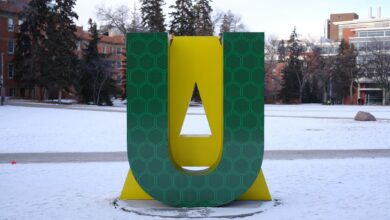 Alex Patterson
Alex PattersonAfter two weeks of waiting in the arctic, ecology professor Andrew Derocher watches the sky clear and listens as his pilot informs the team that it’s safe to fly. Accompanied by two graduate students, Derocher takes off in search of polar bears. Costing upwards of $100 per minute of flying time, the team wants to make the best of good flying conditions while they last.
They fly 10 meters off the ground to look for fresh tracks, or the yellow shape of a bear. After half an hour, they spot one hunting for seal. Derocher loads his tranquilizer with an adequate dose. Once the bear is under, the crew collects samples: a snip of hair, an extracted tooth, an attached radio collar, and a few fat and weight measurements. These will be tested for the bear’s diet, age, and toxicity levels.
A biologist at the University of Alberta, Derocher relies on funding from research grants to conduct his studies. The costs of these studies vary, and financial backing comes from a plethora of sources. Grants are never guaranteed, and finding funding isn’t a skill that’s usually taught in university.
“When I joined the university, nobody sat me down and said, ‘Okay, this is how you need to manage your accounts,’” Derocher says. “It’s just assumed that you’ll learn by trial and error, and errors can be really expensive.”
Derocher estimates that his fieldwork costs several hundred thousand dollars per year. This price tag includes salaries, food, accommodations, travel, equipment, publishing, and safety training. These costs are covered by a collection of granting agencies, each with its own criteria.
As one of Derocher’s research grants nears expiry, he checks to make sure he’s made all necessary purchases with remaining funds. Anything in the grant account after the expiration date will be removed.
***
One of the largest granting agencies in Canada is the Natural Sciences and Engineering Research Council of Canada (NSERC). Established as a replacement for the National Research Council in 1978, NSERC provides $1.1 billion to more than 40,000 researchers and students every year. Through its Discovery Grant, which provides many researchers with a base level of funding, NSERC funds its grantees over a period of one to five years. Between 10 and 20 per cent of Derocher’s own project’s funding comes from NSERC.
Obtaining a Discovery Grant is no easy task, Derocher says. NSERC looks at contributions the applicant has made to research in the form of journal publications. The more studies a researcher has published in high-impact journals such as Nature or Science, the better the chances of getting a grant. Furthermore, a researcher must continue to publish to stay relevant in the field — that is, they can’t coast on past achievements to secure funds in the future.
“Right now, I’m preparing my next NSERC application, and they’re only interested in what I’ve done in the last six years,” Derocher says. “It’s a little like the music industry, where you’re only as good as your last record. In this business, you’re only as good as your last publication.”
Another important criterion that NSERC looks for in Discovery Grant applicants is whether they’ve trained enough students who have obtained Masters’ or PhDs. Training more of these students, called “highly qualified personnel,” increases the chances of earning NSERC funding. This can be difficult for newer researchers since their Master’s students are often just graduating when applications for second-time funding are being submitted.
Once a researcher obtains their second Discovery Grant, they are able to gain the traction needed for academic success.
“The more money you get, the more students you have,” Derocher says. “The more students you have, the more papers you publish. The more papers you publish, the more funding you can get to do research. Once you get on that treadmill, you can quickly move up … it’s a pyramid scheme almost.”
***
Alberto Reyes, an assistant professor in the Department of Earth and Atmospheric Sciences, needs funding for his research on greenhouse gasses during the Eocene, an epoch spanning 56 to 34 million years ago. As carbon dioxide concentrations in today’s atmosphere approach those of the Eocene, his work helps understand environmental changes in the arctic. Gathering data requires him to collect fossil and soil samples in the north. For Reyes, funding can come from sources interested in the arctic, sediments, contamination, or natural hazards.
He received his first grant two years ago, and says he’s still in the process of learning the ropes.
“The trick for people in my position is knowing all of the little spots to go, who to talk to in government to try to get involved and collaborate with government, which comes with a lot of money,” Reyes says. “How do you leverage industry participation?”
Researchers can get a bit of initial help — NSERC provides additional funding for those just entering the field. On a university level, Betty Peavey, the director of research for the Faculty of Science, works with 300 of the faculty’s researchers to help with grant applications.
“Our role here is very supportive,” Peavey says. “The researchers are the ones that have the great ideas and the innovation and the ability to make their program successful and they need money to conduct their experiments and teach their students. We’re here to support them in accessing that money.”
These supports include mentorship and advice through programs like the university’s Grant Assist Program. The program also keeps a library of successful applications so researchers can learn from the success of their peers.
“There’s never a point where we just say, ‘No, you’re not going to get it,’” Peavey says. “We’re just trying to help them be successful.”
Reyes’ — and most researchers’ — largest expense come from staff salaries. A normal salary for a summer research assistant is $8,000, which can rapidly eat up an NSERC grant. And many students want research experience, Reyes says.
“Without financial resources to hire people, you lose that resource,” he says. “It’s a shame because we spend a lot of effort getting students pumped and excited about what we’re doing. So the natural response to that is to want to help on a project. It’s such a downer to be like, ‘I can’t pay you.’”
Many students offer to volunteer, and some researchers take them up on their offer. But Reyes has an ethical problem with that. He feels that it’s only right to compensate students for their help.
Though initiatives like NSERC are in place to provide funding for researchers, according to Reyes, one of the largest limitations of Canada’s current system of funding scientists is that it simply isn’t enough.
“As far back as I can think, the size of the average grant has either shrunk a little bit or stayed constant,” Reyes says. “Expenses go up three to four per cent every year. So there’s been a steady erosion of the buying power of your grant.”
***
Due to this reduction of purchase power, many researchers try to partner with industry to bolster funding. According to Ying Tsui, the associate dean of research and internationalization in the Faculty of Engineering, the success of acquiring industry partnerships depends on a project’s potential economic impacts.
“If you’re very theoretical-based and are working on something without immediate benefit to the industry, it will be much more difficult to find funding,” Tsui says. “But if you are solving a problem and a company needs a solution to that problem, it will be much easier to get that funding.”
According to Kelly Maher, director of research and internationalization for the Faculty of Engineering, industry funding helps researchers because granting agencies often match industry contributions.
“If you have industry putting cash on the table, it’s relatively easy to find funding,” Maher says. “Usually what we’ll do is go after a federal source like NSERC or another federal source, and then go after a provincial source as well. So for every dollar that industry puts in you’re getting at least two dollars and sometimes more from provincial and federal sources.”
According to Tsui, the NSERC program has become more industrial over time, meaning more funding can be granted to projects with industrial partners. In the 2014-15 funding season, industry partners in Alberta contributed more than $27 million to NSERC research projects.
Tsui calls curiosity-driven research “blue sky” research. For Tsui, a balance between blue sky and applied research is paramount. He uses the example of the vacuum tube and silicon semiconductor in computer circuitry. Originally, vacuum tubes were the industry standard and the focus of industrial research. At the same time, other researchers were looking into benefits of silicon in circuitry. Once these benefits emerged, the industry shifted.
“Some (research) might be useful, some maybe not,” Tsui says. “Some technologies may become something in a decade or maybe more than a decade. Some (researchers) are just working on industry issues. When you solve a current problem, you hope to identify future problems.”
Solving these problems requires approaches that extend beyond the natural sciences. Thinktanks such as the U of A foster interdisciplinary collaboration, which is societally important for Tsui. Cross-discipline collaboration can be found, for example, in the Future Energy Systems Research Institute, which was supported by a $75 million grant given to the U of A for energy research. This helps engineers with technical problems, agriculturalists with renewable energy, and researchers in the humanities with energy use.
“You need to look at the whole system, the full cycle for an extended period of time,” Tsui says, “We cannot look at only one dimension when we solve a problem. We have done that in the past and it ends up causing more problems.”
Back at the Derocher laboratory, the “blue sky” work continues. Derocher has to replenish his stock of $1,000-tracking devices, paid for by zoos in the United States in exchange for research findings. He opens an email from the veterinary college that contains hair cortisol values from his latest outing. From these, Derocher is able to determine if mercury levels in polar bears have increased. These tests satisfy requirements set out by the UK conservation group that granted Derocher’s lab funding for this particular test. Though the results likely won’t be published in time to help him with his upcoming NSERC renewal, they will be considered for his next renewal, five years down the line. Derocher is waiting to hear back about grants all the time, and he’s usually preparing his next request, be it for post-doctoral funding, research funding, or equipment funding.
“We’re always writing something up,” Derocher says. “It’s a treadmill and you can never stop.”




